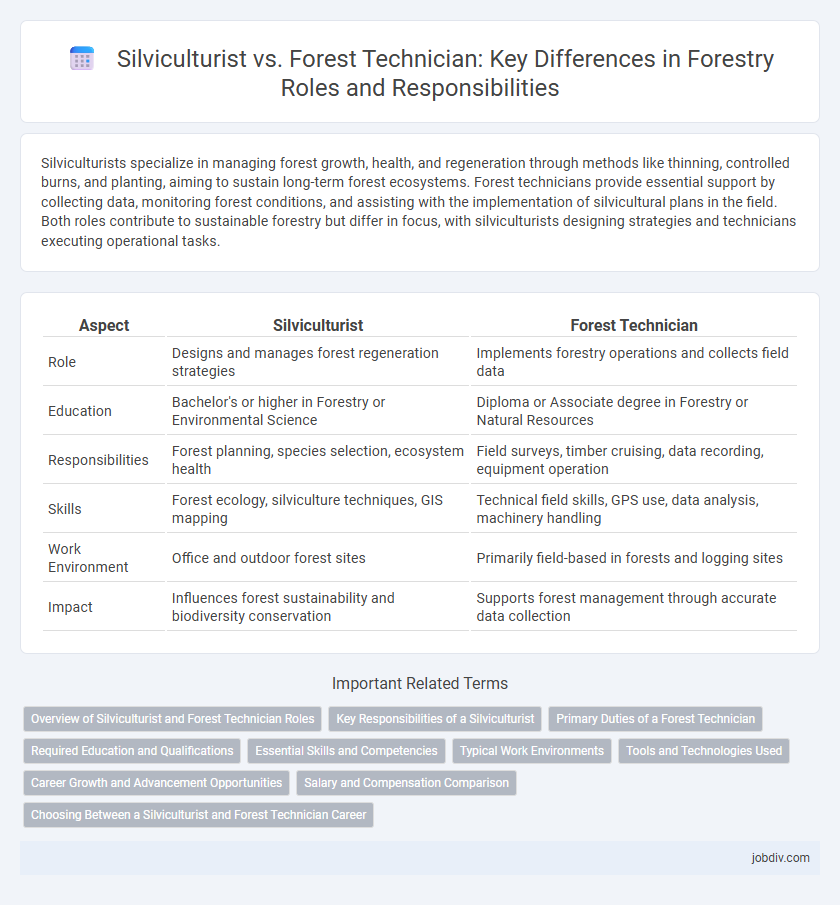Silviculturists specialize in managing forest growth, health, and regeneration through methods like thinning, controlled burns, and planting, aiming to sustain long-term forest ecosystems. Forest technicians provide essential support by collecting data, monitoring forest conditions, and assisting with the implementation of silvicultural plans in the field. Both roles contribute to sustainable forestry but differ in focus, with silviculturists designing strategies and technicians executing operational tasks.
Table of Comparison
| Aspect | Silviculturist | Forest Technician |
|---|---|---|
| Role | Designs and manages forest regeneration strategies | Implements forestry operations and collects field data |
| Education | Bachelor's or higher in Forestry or Environmental Science | Diploma or Associate degree in Forestry or Natural Resources |
| Responsibilities | Forest planning, species selection, ecosystem health | Field surveys, timber cruising, data recording, equipment operation |
| Skills | Forest ecology, silviculture techniques, GIS mapping | Technical field skills, GPS use, data analysis, machinery handling |
| Work Environment | Office and outdoor forest sites | Primarily field-based in forests and logging sites |
| Impact | Influences forest sustainability and biodiversity conservation | Supports forest management through accurate data collection |
Overview of Silviculturist and Forest Technician Roles
Silviculturists specialize in managing and cultivating forest ecosystems, focusing on tree growth, health, and regeneration to ensure sustainable forest development. Forest Technicians support field operations by collecting data, monitoring forest conditions, and assisting with the implementation of management plans under the guidance of foresters and silviculturists. Both roles are essential for effective forest resource management, with silviculturists emphasizing ecological strategies and forest technicians concentrating on practical, on-the-ground execution.
Key Responsibilities of a Silviculturist
Silviculturists specialize in managing forest growth, health, and regeneration through techniques like planting, thinning, and controlled burns to ensure sustainable forest ecosystems. Their key responsibilities include designing and implementing silvicultural treatments, conducting forest inventories, and monitoring tree development to optimize timber production and biodiversity. Unlike forest technicians, silviculturists focus on strategic planning and research to guide long-term forest management decisions.
Primary Duties of a Forest Technician
Forest Technicians primarily conduct fieldwork involving forest inventory, data collection, and mapping to support sustainable forest management. They implement silvicultural treatments such as planting, thinning, and pest control under the guidance of Silviculturists. Their role also includes monitoring forest health and facilitating wildfire prevention strategies to maintain ecosystem balance.
Required Education and Qualifications
Silviculturists typically hold a bachelor's degree in forestry, environmental science, or natural resource management, emphasizing advanced knowledge in forest ecology and silviculture techniques. Forest technicians usually require an associate degree or diploma in forestry technology or a related field, focusing on practical skills and fieldwork experience. Certification such as Registered Professional Forester (RPF) or Certified Forestry Technician (CFT) can enhance job prospects for both careers.
Essential Skills and Competencies
Silviculturists require advanced knowledge in tree biology, forest ecology, and ecosystem management to design and implement sustainable forest regeneration plans. Forest Technicians possess practical skills in field data collection, inventory management, and the use of geographic information systems (GIS) to support forest operations. Both roles demand proficiency in environmental regulations and the ability to analyze forest health, but silviculturists focus more on strategic planning while technicians emphasize operational execution.
Typical Work Environments
Silviculturists typically work in research institutions, government agencies, and large forestry companies, focusing on forest ecosystem management and restoration projects. Forest technicians often operate in the field, conducting surveys, data collection, and implementing forest management plans on logging sites or conservation areas. Both roles require frequent outdoor work but differ in their emphasis on strategic planning versus hands-on operational tasks.
Tools and Technologies Used
Silviculturists utilize advanced tools such as GIS mapping software, tree growth simulation models, and remote sensing technology to plan and manage forest regeneration and health. Forest Technicians primarily use field instruments like diameter tapes, clinometers, GPS units, and sample plot measurement tools to collect and analyze forest data for management and conservation purposes. Both roles increasingly integrate drone technology and data analytics platforms to improve precision in forest assessment and silvicultural decision-making.
Career Growth and Advancement Opportunities
Silviculturists typically experience faster career growth due to their specialized expertise in forest ecology, regeneration, and management planning, which positions them for advanced roles in research and policy development. Forest Technicians often begin with entry-level positions focused on fieldwork and data collection but can advance through gaining certifications and experience to supervisory or operational management roles. Both career paths offer opportunities for leadership, though silviculturists usually access higher-level managerial and consulting positions because of their advanced educational background and technical skills.
Salary and Compensation Comparison
Silviculturists earn an average annual salary between $55,000 and $80,000, reflecting their specialized expertise in forest management and regeneration techniques. Forest Technicians typically receive compensation ranging from $35,000 to $50,000, aligned with their roles in field data collection and operational support. Salary disparities are influenced by education level, geographic location, and years of experience, with silviculturists generally commanding higher wages due to their advanced responsibilities in ecosystem planning.
Choosing Between a Silviculturist and Forest Technician Career
Choosing between a silviculturist and forest technician career depends on your interest in forest management or hands-on technical work. Silviculturists focus on the development and health of forest ecosystems through planning, research, and implementing silvicultural treatments. Forest technicians perform fieldwork, data collection, and assist with the practical application of forest management plans, often requiring strong technical skills and outdoor experience.
Silviculturist vs Forest Technician Infographic

 jobdiv.com
jobdiv.com